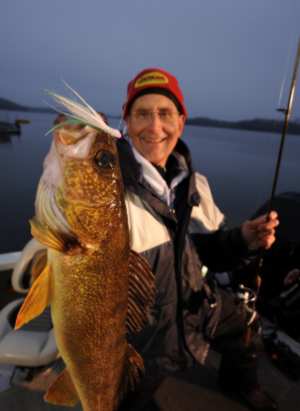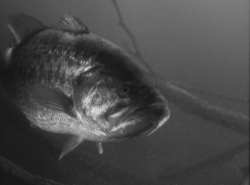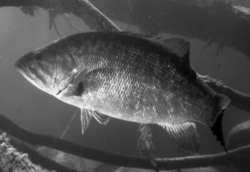It’s a little amusing to consider the level of
technology that’s been applied to the humble pursuit
of angling. For a quest whose only core requirements
are a hook, line, bait and sinker, the addition of military-level
gadgetry can at times leave you feeling a little sheepish.
Not that we mind the advantages.
Satellite-enhanced mapping software pinpoints our location
on the lake, and guides us to potential hotspots. Sonar,
too, continues to advance with brighter pictures and
finer features. And thanks to once top-secret technology,
it’s even become possible to scan the water on
both sides of your boat. There’s nowhere left
for the fish to hide, right? Perhaps not.
The reality is, despite how far we’ve come, most
of the time, we still don’t know what we’re
looking at on sonar—is it weeds, rocks, a sunken
tree, a school of baitfish or a hefty gamefish? And
even then, if the mysterious marks on the sonar screen
are fish, how do we know whether they’re bass,
walleyes, or carp? (No self-respecting bass angler wants
to burn valuable fishing time casting at the “bugle-lipped”
variety.) Even more perplexing is the process of finding
fish that hide in cover—burrowed into weedbeds,
encased in brushpiles, hugging boulders or hunkered
under boat docks. For a sonar unit, the task must seem
a little like playing an unsolvable game of “Where’s
Waldo?”

Underwater camera practitioner Bruce “Doc”
Sampson earns a competitive edge in tournaments
by visually exploring walleye habitat in the
days leading up to an event. This particular
walleye gobbled up a Northland Buck-A-Roo Jig
worked along one such fast-falling edge. Photo
courtesy of Bill Lindner Photography
|
Beyond all this is the fact that bass, walleyes
and most other fish relate strongly to drop-offs.
All anglers know this, and take it for granted.
Yet due to the nature and shape of sonar signals,
many of these drop-off fish never appear on
the graph screen. As a result, anglers are bypassing
some of the most untouched fish in their lakes.
It’s for all these reasons and more that
many topflight fishermen still rely on an underwater
video camera, such as the breakthrough MarCum
VS380. Whenever these elite anglers need to
find fish and ‘learn the lay of the land,’
they bust out the camera. There is simply no
better tool for finding fish—the “right”
fish—as well as understanding their habitat.
Unlike the virtual fish seen on sonar, camera
information is reality. It’s roughly the
same difference as watching the movie Bambi,
or taking a long walk in the forest. The movie
might give you a virtual slice of the wild,
but a day spent in the woods gives you an authentic
backwoods experience—the crack of twigs
beneath your boots, the smell of pine needles,
and a face-to-face encounter with a wild buck
whitetail.
|
Bass anglers such as the famed Roland Martin, Bernie
Schultz, Joe Balog and many others have at one time
all relied on the visual advantages of a camera. The
reality is, when bass need to be found, especially larger
tournament winning fish that hide in heavy cover, tournament-tested
anglers pull out their camera, and they certainly don’t
tell anyone about it. These devices truly are one of
the only secrets left in the tournament game.

With sonar, it’s nearly impossible to
reveal fish – such as this piggish largemouth
– that duck amongst heavy timber, not
to mention lilypads, rushes, rocks, even under
docks. This image was captured on a MarCum VS380
underwater camera. Photo courtesy of MarCum
Technologies (www.marcumtech.com)
|
Bass Viewing Strategies
Whether bass are spread across broad shallow
wood or weed-strewn flats, hidden under boat
docks or concentrated along drop-offs, a camera
remains the finest means of determining their
location. The camera also reveals the species
and size of fish, as well as precisely how they’re
positioned relative to cover or the bottom.
Viewing bass and the cover they live in is
best accomplished by moving slowly along a breakline
or over a flat with a foot-controlled trolling
motor. With a compact system, such as the MarCum
VS380, an angler can sit and cradle the monitor
on his lap, while feeding and retrieving camera
cable with a casting arm over the side of the
boat. The entire system is protected from the
elements with a weatherproof padded soft pack.
|
Meanwhile, specialized light-sensitive optics on MarCum’s
premium Sony Super HAD CCD adjusts to water clarity,
and yields the sharpest picture possible at all times.
The video is so vivid that several national fishing
show producers record footage right off the MarCum system.

From a boat, an angler can lower the lens of
an underwater camera into incredibly thick cover
and look for pockets that hold fish. This image
was captured on a MarCum VS380 underwater camera.
Photo courtesy of MarCum Technologies (www.marcumtech.com)
|
While cruising along
at a steady speed, the camera “swims”
along below, providing a wide 90-degree view of
the underwater terrain. You can maneuver it easily
through dense vegetation, over and alongside thick
wood cover, even bump right up against boulders
that conceal giant smallmouths. Some anglers even
position their camera to peek under boat docks
or thick matted cover, such as lily pads and hydrilla.
By attaching the camera to a 15-foot telescoping
pole, as Roland Martin has often done, it’s
also possible to see largemouths tucked well up
under docks and other floating objects. As many
anglers have learned, it’s one of the best
ways to prefish a tournament. Use the camera to
find big groups of large bass, all without having
to put hooks in them or reveal to other anglers
your winning school. Punch in a GPS waypoint,
and return on tournament day to load the livewell.
|
Revealing Walleyes that Sonar Misses
Walleyes love drop-offs, but sonar signals don’t.
As the cone-shaped sonar beam reads along a steep break,
blind spots occur that obscure fish from coming into
view. Walleye tournament ace Doc Samson explains the
phenomenon. “Often, the closest solid object to
the transducer is the sloping edge to the side of the
boat, even though it’s not directly beneath the
transom. In these drop-off scenarios, the sloping edge
blocks or screens out a section of water. Usually, this
sonar “dead-zone” lies at the pivot point
between the base of the drop and the deeper flat. This
is a key walleye concentration zone, which is often
overlooked.”
Samson suggests taking a camera for a test drive along
one of these drop-offs. Watch how many walleyes you
spot on the camera screen that don’t show up on
sonar. You might be amazed by how many fish you’ve
been missing; how many fish you could have been catching.
Beyond the powerful fish-finding abilities of underwater
cameras is the confidence they lend to your fishing.
Rather than a virtual mental image of “pixel fish,”
the camera fills your mind with a clear and accurate
picture of the whole underwater world. You see the low-slung
jaw of a heavyweight largemouth, the white-tip of a
walleye’s tail. You picture precisely how they’re
positioned in relation to cover and structure, which
tells you exactly how to present your lure. Almost before
it happens, you perceive the strike—gills flare,
the bait disappears, and your rod bends with deep surging
arcs.
Most commonly associated with fishing on the ice, the
underwater camera is the perfect companion in the boat
– it’s willing to stick it’s head
underwater and file reports; won’t cut off your
casts to the best spots; doesn’t talk back; and
stows easily away at the end of the day so you don’t
have to cover its tab at the tavern.



